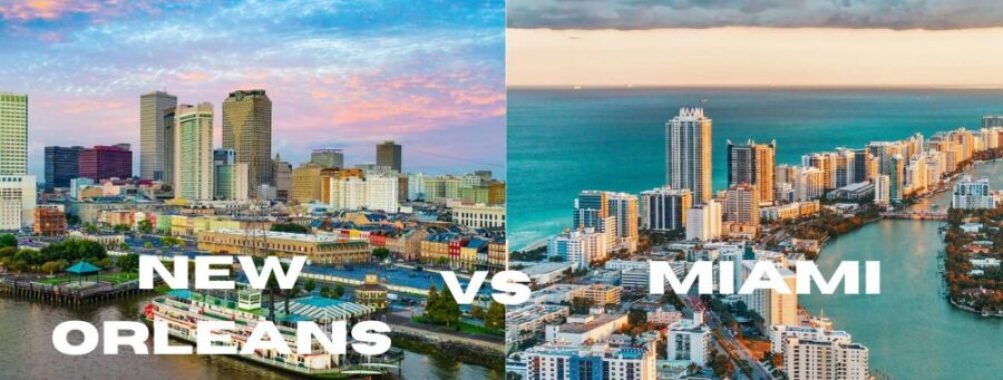
New Orleans vs Miami: Battle of Two Cultural Hotspots Reveals Best Winter Escape 2025
Miami and New Orleans stand as two of America’s most unique cultural hotspots. Both cities pulse with energy, yet each offers travelers a completely different flavor of Southern charm. Miami dazzles with its glamorous beaches and Latin flair, while New Orleans captivates with its deep-rooted history and Creole soul.
For most travelers, New Orleans makes a better choice for those seeking authentic culture, incredible food, and historic charm, while Miami wins for beach lovers, luxury seekers, and those who prefer modern attractions. The choice comes down to whether you want to experience the warm waters of South Beach or the warm hospitality of the French Quarter.
These sister cities of the South both embrace diversity and celebration, but they express it in distinct ways. New Orleans moves to the rhythm of jazz in century-old venues, while Miami grooves to salsa beats in sleek South Beach clubs.
Contents
- Historical Background
- Foundations of New Orleans
- Miami’s Growth and Development
- Cultural Tapestry
- The Melting Pot of New Orleans
- Miami’s Diverse Heritage
- Climate and Environment
- Weather Patterns in New Orleans
- Miami’s Sunny Climate
- Geographic and Urban Appeal
- Cityscapes: New Orleans’ Unique Layout
- Miami’s Iconic Beachfronts and Skylines
- Economic Landscape
- New Orleans’ Economic Indicators
- Miami’s Thriving Economy
- Social and Lifestyle Attractions
- New Orleans’ Vibrant Nightlife and Festivities
- Entertainment and Relaxation in Miami
- Accommodation and Hospitality
- Hotels and Guesthouses in New Orleans
- Resorts and Boutique Hotels of Miami
- Accessibility and Transportation
- Navigating New Orleans
- Getting Around Miami
- Educational and Career Opportunities
- Schools and Universities in New Orleans
- Miami’s Professional and Academic Scene
- Frequently Asked Questions
- What cultural differences distinguish New Orleans from Miami?
- How do the culinary scenes in New Orleans and Miami compare?
- In terms of festivals and events, how do New Orleans and Miami differ?
- Which city offers a more vibrant nightlife, New Orleans or Miami?
- How do the annual climate and weather patterns contrast between New Orleans and Miami?
- Can you compare the historical significance of New Orleans with Miami?
- More Travel Guides
Historical Background
New Orleans and Miami emerged as vibrant cultural centers, each shaped by distinct influences that created their unique identities. Both cities faced major challenges from hurricanes and natural disasters while developing into the diverse metropolitan areas we know today.
Foundations of New Orleans

The French established New Orleans in 1718, building it into a crucial port city. The French Quarter became the heart of the city with its iconic architecture and iron balconies.
Trade along the Mississippi River helped New Orleans grow into a major commercial hub. The city mixed French, Spanish, and African influences to create its own special culture.
The city survived fires, floods, and yellow fever outbreaks in the 1800s. Each challenge made the community stronger and more resilient.
Streets filled with jazz music by the early 1900s. Local musicians created a new sound that spread worldwide.
Miami’s Growth and Development

Miami started as a small trading post in the 1800s. The city got its big break when Henry Flagler brought his railroad there in 1896.
The 1920s land boom transformed Miami from a frontier town into a vacation spot. Art Deco buildings went up along Miami Beach, giving the city its signature style.
Cuban immigrants arrived in large numbers after 1959. They built Little Havana and added new flavors to Miami’s culture.
The city became an international gateway in the 1980s. Tourism, banking, and trade with Latin America turned Miami into a global city.
Cultural Tapestry
Both cities showcase unique cultural identities shaped by centuries of immigration and historical influences. Their distinct flavors, music, and traditions create unforgettable experiences for visitors.
The Melting Pot of New Orleans

The French Quarter buzzes with the sounds of jazz pouring from local clubs. Street performers add their own flair to the city’s vibrant music scene, making every corner feel alive with rhythm.
Creole cuisine defines New Orleans food culture. Local specialties like gumbo and jambalaya blend French, African, and Caribbean influences. These dishes tell stories of the city’s rich heritage through their complex flavors.
Café du Monde serves up crispy beignets covered in powdered sugar – a French-inspired treat that’s become a New Orleans icon. The café’s 24-hour service makes it perfect for late-night cravings or early morning coffee.
Mardi Gras transforms the city each year with parades, masks, and celebrations. The festival brings together locals and tourists in a display of New Orleans’ unique cultural spirit.
Miami’s Diverse Heritage

Latin rhythms and Cuban beats fill Miami’s streets, especially in Little Havana. This neighborhood serves as the heart of Cuban-American culture with its ventanitas (coffee windows) and domino players.
Food stands out as a key part of Miami’s identity. Must-try dishes include:
- Cuban sandwiches pressed to perfection
- Ropa vieja (shredded beef in tomato sauce)
- Fresh stone crab during season
- Pastelitos (Cuban pastries)
Art Deco buildings line South Beach, showing off Miami’s architectural heritage. These colorful structures from the 1920s and 30s give the area its distinctive look.
Street art covers the walls in Wynwood, where artists from around the world have created an outdoor museum of modern culture.
Climate and Environment
Both Miami and New Orleans share humid subtropical climates with plenty of rain and heat, yet each city has its own distinct weather patterns that shape daily life and tourist activities.
Weather Patterns in New Orleans

New Orleans sees more rainfall than Miami, getting about 63.5 inches per year. The city experiences hot, sticky summers with July highs reaching 91.8°F.
Winter brings more temperature swings than Miami. January lows can drop to 45.1°F, making light jackets needed for morning walks in the French Quarter.
The city’s location near Lake Pontchartrain and the Mississippi River creates a unique microclimate. This leads to quick weather changes and afternoon thunderstorms, especially in summer months.
Miami’s Sunny Climate

Miami boasts about 248 sunny days per year, perfect for beach trips and outdoor activities. The weather stays warm year-round, with July highs around 89.2°F.
Winter remains mild and pleasant. January lows rarely drop below 60.6°F, making Miami a popular escape for winter tourists.
The city gets about 59.3 inches of rain yearly. Most rainfall comes in brief afternoon showers during summer months.
Biscayne National Park and local beaches benefit from the tropical climate. The warm waters support coral reefs and marine life, while the Everglades’ unique ecosystem thrives in the mix of dry and wet seasons.
Geographic and Urban Appeal
Both cities offer distinct urban landscapes shaped by their unique geography and history. Miami’s coastline and New Orleans’ Mississippi River connections create two very different but equally fascinating cityscapes.
Cityscapes: New Orleans’ Unique Layout

The French Quarter stands as the crown jewel of New Orleans’ urban design, with its historic grid pattern and Spanish colonial architecture. Iron balconies and hidden courtyards line narrow streets that tell stories of the city’s rich past.
Streetcars rumble through the Garden District, where massive oak trees create natural canopies over the streets. The 1,300-acre City Park ranks among America’s oldest urban parks, featuring centuries-old trees draped in Spanish moss.
Bourbon Street pulses at the heart of the French Quarter, where buildings from the 1700s and 1800s showcase French and Spanish influences. The city’s layout follows the natural curve of the Mississippi River, creating its nickname “The Crescent City.”
Miami’s Iconic Beachfronts and Skylines

South Beach dazzles with its pastel-colored Art Deco buildings, making it one of the largest collections of this architectural style in the world. The beachfront Ocean Drive features over 800 preserved historic buildings.
Miami’s modern skyline rises dramatically along Biscayne Bay, with gleaming glass towers reflecting the tropical sun. The city’s urban core blends seamlessly with its natural setting of white-sand beaches and turquoise waters.
Palm-lined streets and waterfront mansions characterize exclusive neighborhoods like Star Island and Palm Island. The city’s coastal location shapes its development, with countless waterfront properties and marina-front dining spots.
Economic Landscape
Miami and New Orleans show stark economic differences, with Miami leading in most key indicators like household income and employment rates. The cities have distinct costs of living and business landscapes that shape daily life for residents.
New Orleans’ Economic Indicators

New Orleans faces some economic challenges with an 11% unemployment rate. Workers earn about 5% less than their Miami counterparts, with salaries falling 51% below the national average.
The city makes up for lower wages with much cheaper living costs. Housing expenses are 51.2% lower than Miami. A typical salary stretches further here – covering about 1.8 months of expenses compared to 1.4 months in Miami.
Management and business roles make up 15.9% of jobs in New Orleans. The shorter average commute time saves workers about 4.4 minutes each way compared to Miami.
Miami’s Thriving Economy

Miami maintains an 8.3% unemployment rate and higher household incomes than New Orleans. The job market features a strong 17.1% concentration in management, business and finance roles.
The robust economy comes with steep costs. Housing prices run more than double those in New Orleans. Basic living expenses are 43% higher across the board.
Despite higher costs, Miami’s economic strength shows in its GDP and productivity metrics. The diverse job market spans industries from tourism to international trade.
Daily commutes run longer than New Orleans, though the transportation network supports the larger workforce with multiple transit options.
Social and Lifestyle Attractions
Both cities offer unique social scenes and entertainment options that showcase their distinct cultural identities. From live music venues to world-class dining, these destinations create unforgettable experiences for visitors.
New Orleans’ Vibrant Nightlife and Festivities

The streets of New Orleans pulse with energy every night. Frenchmen Street stands out as the heart of live jazz, with local musicians playing in cozy clubs and bars. You’ll find talented performers playing everything from traditional jazz to modern funk.
Mardi Gras transforms the city into the world’s biggest party. The celebration brings parades, costumes, and excitement that can’t be found anywhere else in America.
Beyond music and festivals, the French Quarter offers unique shops selling local art, antiques, and crafts. Street performers entertain crowds on every corner.
Families can spend time at the Audubon Zoo, home to rare white alligators and beautiful gardens. The zoo provides a peaceful break from the city’s lively atmosphere.
Entertainment and Relaxation in Miami

Miami’s social scene centers on its glamorous nightclubs and rooftop bars. The city comes alive after dark with world-famous DJs and exclusive venues that attract celebrities and party-goers.
The Wynwood Walls area has become Miami’s creative hub. This outdoor museum showcases stunning street art and hosts regular cultural events. The neighborhood is filled with art galleries, hip coffee shops, and trendy restaurants.
Miami’s shopping districts range from luxury boutiques to colorful markets. The Design District features high-end fashion stores, while local markets offer unique finds and Cuban crafts.
Young families enjoy the interactive museums and science centers spread throughout the city. Many hotels provide special programs for kids, making Miami a great choice for all ages.
Accommodation and Hospitality
Both cities offer unique places to stay, from historic properties to modern luxury hotels. Miami tends to focus on beachfront resorts, while New Orleans specializes in charming historic properties.
Hotels and Guesthouses in New Orleans

New Orleans shines with its collection of historic boutique hotels in the French Quarter. Many buildings date back to the 1800s, featuring wrought-iron balconies and interior courtyards.
The city’s guesthouses provide excellent value for money. These smaller properties often include breakfast and offer more personal service than large hotels.
Historic properties like converted mansions and renovated warehouses give visitors a taste of old-world charm. Many rooms feature exposed brick walls and original architectural details.
Budget travelers can find good deals in the Garden District and Marigny neighborhoods. These areas offer a mix of small hotels and bed-and-breakfasts at lower prices than the French Quarter.
Resorts and Boutique Hotels of Miami

Luxury beachfront resorts dominate Miami’s accommodation scene. South Beach hosts the most exclusive properties, with rooftop pools and private beach access.
Boutique hotels in Miami’s Art Deco district showcase stunning 1920s and 1930s architecture. These smaller properties offer intimate settings with stylish design touches.
Coconut Grove and Coral Gables provide quieter alternatives to busy South Beach. These neighborhoods feature upscale hotels surrounded by lush gardens and tropical landscapes.
Miami’s newer hotels emphasize modern amenities and technology. Many offer smart room controls, high-end spas, and multiple restaurants on-site.
Mid-range options exist in Downtown Miami and Brickell. These areas cater to business travelers but work well for tourists who want to avoid beach crowds.
Accessibility and Transportation
Both Miami and New Orleans offer distinct transit options that shape the visitor experience, from modern airport connections to unique ways of exploring city streets.

The Regional Transit Authority runs buses and the famous red streetcars through New Orleans. Streetcars cost just $1.25 per ride and connect major areas like the French Quarter, Garden District, and downtown.
Wheelchair users will find many buses with low-floor entry and ramps. Most popular attractions offer accessible entrances and facilities.
Walking works well in tourist areas, with flat terrain and wide sidewalks in the French Quarter and Garden District. Bike lanes are limited but growing, especially along the Mississippi River trail.
Rideshare services fill transportation gaps, particularly late at night or when heading to spots outside streetcar routes.
Getting Around Miami

Miami International Airport sits just 8 miles from downtown, with direct connections to rental cars and public transit. The Metrorail links the airport to popular areas like Downtown and Coral Gables.
The Metromover offers free automated transit around downtown Miami. It connects with Metrobus routes that reach Miami Beach and other neighborhoods.
Search flights and rental cars to plan your Miami transportation.
Miami’s flat terrain makes biking popular. Protected paths run along the beach and through neighborhoods like Coconut Grove.
Most tourist spots meet ADA standards with ramps and accessible facilities. Beach wheelchairs are available at many public beaches.
Educational and Career Opportunities
Both cities offer distinct paths for learning and career growth, with New Orleans known for its historic institutions and Miami’s modern business landscape creating unique professional opportunities.
Schools and Universities in New Orleans

The heart of New Orleans’ education scene is Tulane University, a prestigious research institution that attracts students from around the globe. The city also houses Loyola University and the University of New Orleans, creating a rich academic environment.
Xavier University stands out as America’s only historically Black Catholic university. It’s famous for sending more African American students to medical school than any other college in the U.S.
Local schools benefit from smaller class sizes compared to Miami, with better student-teacher ratios that allow for more personal attention.
Miami’s Professional and Academic Scene

The University of Miami leads the city’s academic landscape as a top-ranked private research university. Florida International University adds to the mix with its strong focus on international business programs.
Miami’s job market shows promising signs for career seekers. The city has seen a 17.9% job growth over the past decade, with continued positive trends.
The city’s strong ties to Latin America create unique opportunities in international trade and finance. Many global companies have regional headquarters here, opening doors for career advancement.
Local industries focus on tourism, technology, and healthcare, providing diverse career paths for graduates.
Frequently Asked Questions
Both New Orleans and Miami captivate visitors with distinct cultural identities, vibrant food scenes, and unique celebrations that make each city special in its own way.
What cultural differences distinguish New Orleans from Miami?
New Orleans embraces French, African, and Creole influences that blend into a unique cultural gumbo. The city’s architecture features French Quarter balconies, Creole cottages, and historic streetcars.
Miami shines with strong Cuban and Latin American influences, especially in Little Havana and Calle Ocho. Art Deco buildings in South Beach and colorful murals in Wynwood showcase the city’s artistic spirit.
How do the culinary scenes in New Orleans and Miami compare?
New Orleans serves up authentic Cajun and Creole dishes like gumbo, jambalaya, and crawfish étouffée. Local institutions dish out po’boys and beignets that bring crowds back again and again.
Miami’s food scene centers on Cuban cuisine, fresh seafood, and fusion restaurants. Cuban sandwiches, stone crabs, and ceviche highlight the city’s coastal Latin flavors.
In terms of festivals and events, how do New Orleans and Miami differ?
New Orleans throws the world-famous Mardi Gras celebration with weeks of parades, masquerade balls, and street parties. The city also hosts Jazz Fest and countless food festivals throughout the year.
Miami lights up with events like Art Basel, Ultra Music Festival, and the South Beach Wine & Food Festival. The Calle Ocho Festival celebrates Cuban culture with music, food, and dancing.
Which city offers a more vibrant nightlife, New Orleans or Miami?
New Orleans keeps the party going on Bourbon Street with live jazz clubs, dive bars, and music venues. The French Quarter buzzes with energy as visitors hop between historic bars with go-cups in hand.
Miami’s nightlife sparkles in South Beach with glamorous clubs, rooftop bars, and beach parties. Little Havana offers authentic salsa clubs where locals dance until sunrise.
How do the annual climate and weather patterns contrast between New Orleans and Miami?
New Orleans experiences hot, humid summers and mild winters. The city faces hurricane risks from June through November, with frequent afternoon thunderstorms in summer months.
Miami enjoys warm weather year-round with hot summers and pleasant winters. The city sees occasional tropical storms but benefits from cooling ocean breezes.
Can you compare the historical significance of New Orleans with Miami?
New Orleans dates back to 1718 and played a crucial role in American history as a major port city. The French Quarter preserves centuries of architecture and cultural traditions.
Miami emerged as a major city in the early 1900s. The city transformed from a small trading post to an international hub shaped by waves of Cuban immigration and tourism development.



